Greetings from Palmia Observatory
Well, here we are already in May, and even though we have lots of conferences and observations to go over, my Ipad reminded me of several images from the past, so let's first begin with a sample of those.
First up, is a view of Resident Astronomer Peggy and I, in front of one of the radio antennas that make up the Goldstone Tracking Station in Fort Irwin, CA. We enjoyed this reminder from the past and look forward to visiting other observatories and sites in the future
 |
| Blast from the Past (2015), Goldstone Tracking Station (Source: Palmia Observatory) |
Another picture from the past was when Janna Levin, astrophysicist, author of "Black Hole Blues..." was at a book signing event in Altadena, CA. We had a presentation followed by discussion and wine and of course, signing of her new book. As a physicist wannabe, it is always nice to meet and real physicist.
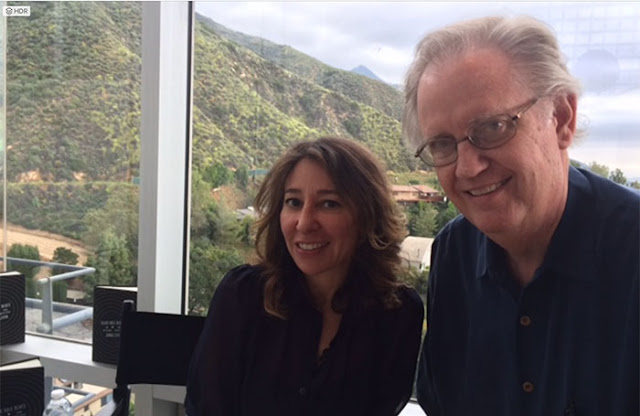 |
| Janna Levin signs her book, "Black Hole Blues", 2016 (Source: Palmia Observatory) |
A final blast from the past photo reminder was this photo taken during a 2016 OCA star party at Black Star Canyon. Here the Resident Astronomer and "Mad about Mars, Eric" show off their setups. Wow, it is sad, just to think that it has been over 2 years now that we have gone without any big group star gazing events.
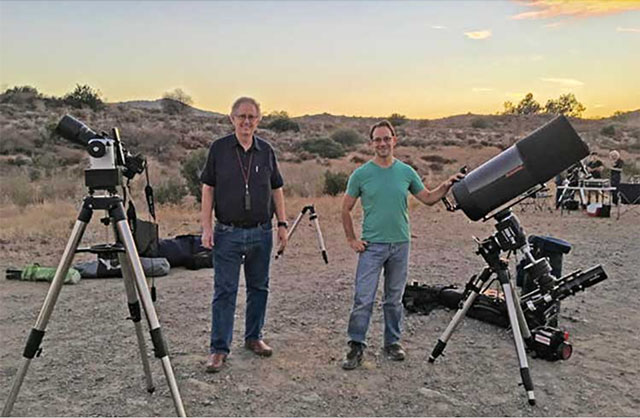 |
| Black Star Canyon observing (2016) with "Mad about Mars, Eric" (Source: Palmia Observatory) |
Ok, that is enough Blast from the Past, now on to the just past, May,2-4, 2022, Mars Exploration Program Analysis Group (MEPAG) meeting, held in Denver, but attended by us here online. The research activities of MEPAG are outlined in this screenshot of one of the presentation slides.
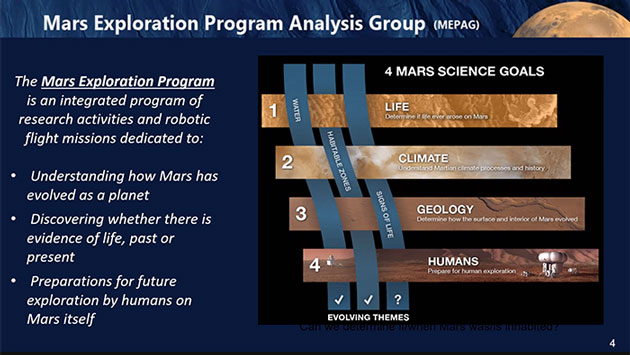 |
| MEPAG Meeting May 2-4, 2022 (Source: MEPAG 2022) |
Another slide shows the priority science questions addressed by MEPAG.
 |
| MEPAG Priority Science Questions (Source: MEPAG 2022) |
The month of May also brought us a grand alignment of planets for astroimagers. In this city lights viewing image, you can see, Venus, at the lower left, then Jupiter, Mars and Saturn, at upper right. Still exhibiting lazy astronomer syndrome, I set up the flimsy tripod pretty close to a streetlight, which pretty much blasted out the lower left side of the image.
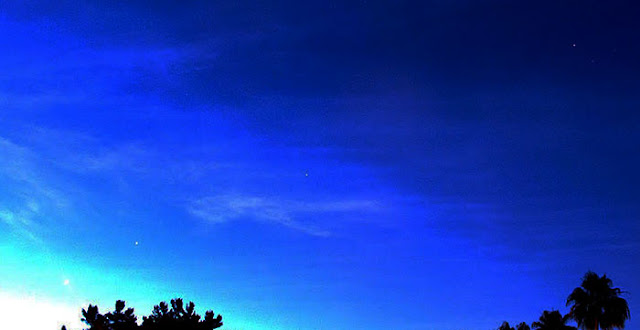 |
| Planetary alignment with Venus, Jupiter, Mars and Saturn, DSLR 18mm, 4 sec (Source: Palmia Observatory) |
The other big news of the week was disclosed at the Event Horizon Telescope (EHT) where the first image of the black hole, Sgr*, a the center of the Milky Way was obtained. Sgr* is less than 1/1000 as big as the black hole in M87. Sgr* is also about 1000 times closer to us. But the small size of Sgr* means that the hot swirling gas that is accreting onto the black hole is moving very fast, close to the speed of light, and complicates getting a good image of the black hole. So, the image, which is observed at radio frequencies and displayed in false color, shows how the imaging algorithm blurs out any detail. Note the size comparison of the black hole event horizon for the two black holes.
 |
| Hooray, image of Sgr* Black Hole & M87 comparison (Source: EHT Collaboration Press Conference) |
We were also treated to a lunar eclipse on May 15-16, 2022. This was an excellent chance to drag out the flimsy tripod and do some nighttime observing and photography. This photo was taken during the total eclipse period.
 |
| Total Lunar Eclipse, DSLR 300mm, 2 seconds (Source: Palmia Observatory) |
While we were outside waiting for the eclipse to end, we noticed several opportunities when an aircraft flew close to the moon in the sky. So, during on close encounter, I switched from 300mm telephoto lens setting to 75mm, and was able to capture the aircraft navigation lights at the bottom left side of this image.
 |
| Total Lunar Eclipse & Airplane, DSLR 75mm, 2 seconds (Source: Palmia Observatory) |
As the eclipse was ending, you could see one edge of the moon become brighter and brighter. Here you can see, how with the same 2 second exposure setting, part of the moon is becoming completely saturated.
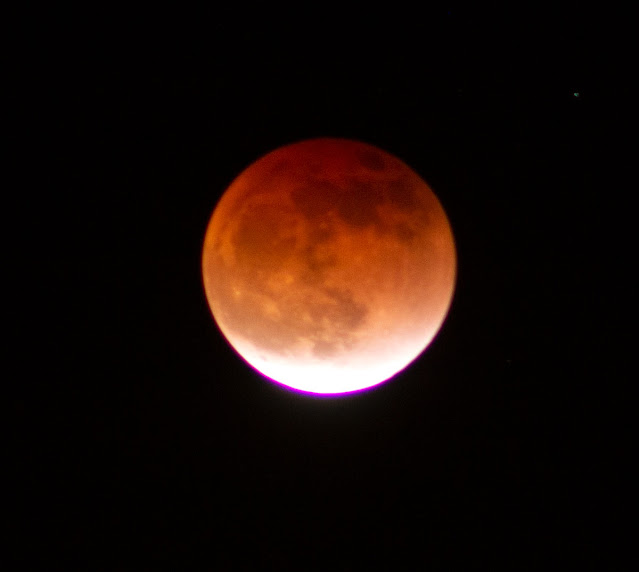 |
| Exiting Lunar Eclipse, DSLR 300mm, 2 seconds (Source: Palmia Observatory) |
Then as more and more of the moon comes out of the eclipse, we see it is difficult with the 2 second exposure setting to see any detail on the portion of the moon that is not eclipsed.
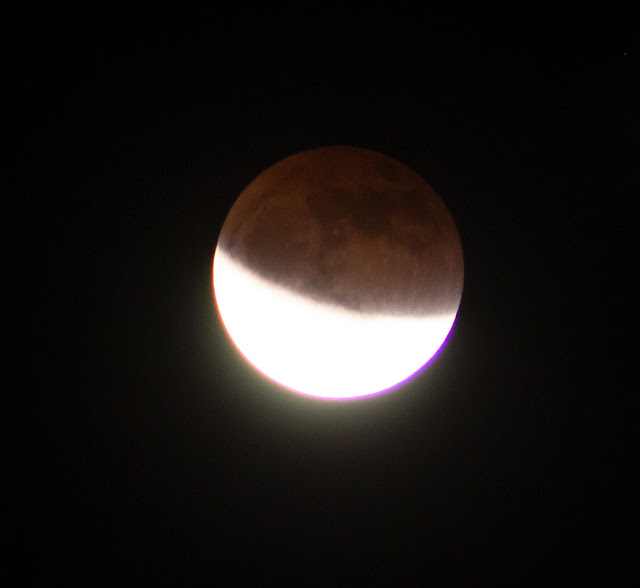 |
| Exiting Lunar Eclipse, DSLR 300mm, 1/4 seconds (Source: Palmia Observatory) |
But, when the exposure setting is changed from 2 seconds to 1/250 seconds, we can now start to see some of the lunar detail, Hooray; it was fun to get outside and look up!
 |
| Exiting Lunar Eclipse, DSLR 300mm, 1/250 seconds (Source: Palmia Observatory) |
For the rest of this week we will be attending the online version of the AbSciCon2022, held in Atlanta, GA. This astrobiology conference has a subtitle: From Stars to Cells. It would have been nice to attend in person, but the conference seems to be a little too technical for me and also didn't want to be doing any additional travelling so close to our upcoming river cruise from Paris to Prague. Anyway, we might make some comments about the conference during our next blog posting.
| AbSciCon2022" Origins, Worlds and Life (Source: AbSciCon2022) |
Finally, we have watched the unfolding events of the Russian invasion of Ukraine, and wanted to finish up this blog post with some comments about that. This photo image shows just one example of the ongoing destruction of the country. It is so sad to learn of all the pain, suffering and death of so many innocent people.
 |
| Heavy damage in Ukraine (Source: Reuters) |
So, as part of an upcoming Philosophy Meetup group, I have been preparing a two-minute summary of some philosophical comments and questions. I present the current summary, here, not associated with astronomy, not as some kind of final expert opinion, but just a written homework essay, written for discussion:
 |
| Philosophy Meetup Homework Essay about Ukraine (Source: Palmia Observatory) |
Until next time,

No comments:
Post a Comment